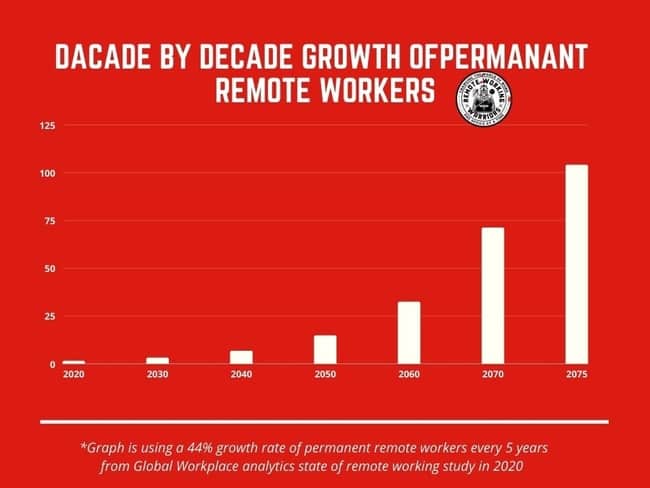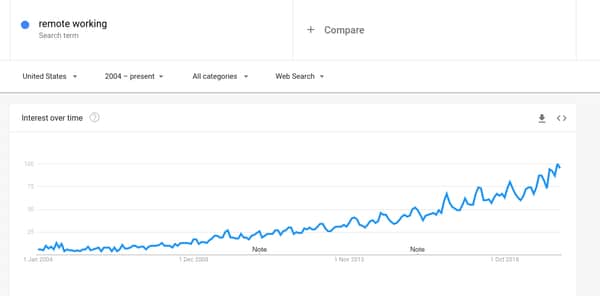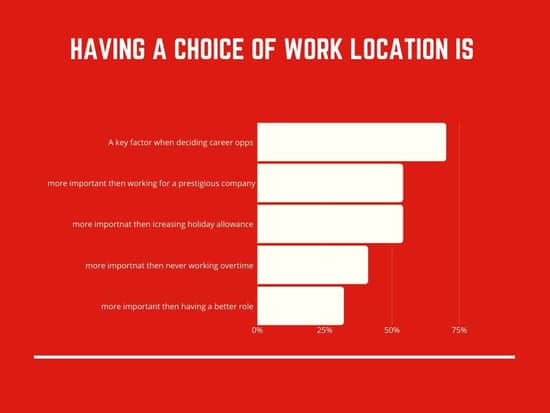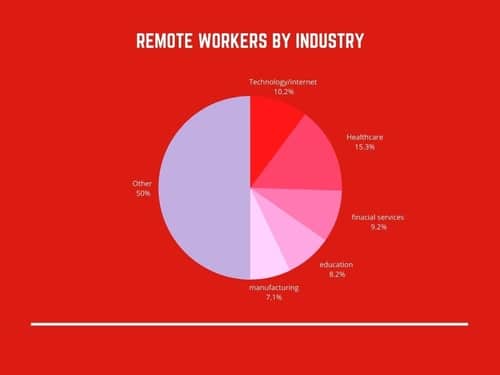This website is supported by its readers. If you click one of my links I may earn a commission. I am also a participant in the Amazon affiliates programme and I will also earn a commission from qualified purchases.

One of the things I wondered about when first starting my remote working journey was if this was something that was going to be special for my current role, or if the entire industry (sales) was moving this way. With Covid-19 changing a lot of the ways that businesses think of flexible working options, will remote working become the new normal?
Remote working and working from home will become the new normal. Working from home has grown by 126% over the past 12 years and at this continuing rate there will be almost 10 million permanent remote workers by 2030 with many more having the option to work remotely.
Working from home will be a successful long term future trend if employers continue to make the structural changes needed for remote working.
So why is working from home becoming more popular? And are there some industries that will move to a work from home workforce faster than others? Keep reading to find out more?
Now it’s worth mentioning that this post has a lot of information and so if you’re curious about the best equipment needed to work remotely simply go to my resource page here.
Will work from home be the new norm
So unless you’ve been living under a rock for the past few months working from home and working remotely has pretty much been a way of life for most of us and will continue to be until the pandemic has run its course.
Whilst working from home definitely has its advantages, one thing on a lot of employees minds is will working from home be the new norm.
In a nutshell it will, but it might take slightly longer then you might have anticipated
According to most statistics there are currently 4.7 million permanent remote workers working in the USA at the moment. Remote working has grown by 44% over the past 5 years which is a sharp rise mainly due to better internet connections and a more serviced based workforce.
If we use this (very concervative) growth rate of 44% every 5 years we can estimate that it would take almost 65 years for there to be a 100% permanent remote workforce in the USA.
| Number of permanent remote workers | Decade | Percentage of US Population | US Population growth by decade (data gathered from: US CENSUS) |
| 4,700,000 | 2020 | 1.43 | 328,200,000 |
| 10,924,129 | 2030 | 3.10 | 352,133,333 |
| 25,390,764 | 2040 | 6.75 | 376,066,667 |
| 59,015,314 | 2050 | 14.75 | 400,000,000 |
| 137,168,274 | 2060 | 32.36 | 423,933,333 |
| 318,817,848 | 2070 | 71.19 | 447,866,666 |
| 486,056,889 | 2075 | 105.70 | 459,833,333 |
Source: https://www.census.gov/programs-surveys/popproj.html

A few things to note about the table:
- It doesn’t take into consideration the different industries people work in with some industries always having a office based role such as teachers, doctors judges and the manufacturing industry
- It does not take into consideration human preference, human beings are social creatures and may want to be present in an office to bounce off their colleagues.
- A 44% growth curve every 5 years is likely to increase based on better technology and more cloud based jobs becoming available so this could be faster.
Using this information we can say that around 50% of roles that have the ability to work remotely permanently will be permanently remote by 2065 – Doesn’t seem like a new norm now does it?
These results are a little misleading, you see the figures above only count towards those employees that are based remotely 100% of the time. If we were to change this to the percentage of employees who have the ability to work from home at least one day per week, this is where the real magic is happening:
- 52% of employees globally option to work remotely at least one day per week.
- By 2028, 73% of all departments in the USA will have the option to work from home one day per week.
- 34% of employees who have the option of working from home once per week do so.
Using these stats then we see that whilst the number of permanent remote workers is steadily growing the amount of part time remote workers is growing rapidly, having a huge impact on the modern workforce
From this then we can come to the following conclusion to id working from home will be the new norm:
Whilst the number of permanent remote working and working from home positions will grow steadily over the next few years, the amount of employees with the option to work from home a few days a week is rapidly becoming the new normal.
Why are companies moving towards remote working ?
So now we know that working from home and remote working is becoming the new normal, why are organizations moving towards this as a work scheme. After all for so many years companies have been dead against the idea haven’t they?
Why do organisations let their employees work from home?
Organizations are moving towards a remote working policy because of technology, cost savings and environmental factors. Internet connections have finally got to the point amongst most households where employees can do their job from anywhere around the world. Employers also save a large amount not having to pay bills for their employees to work from an office and more employees are expecting this as the norm and so only look for roles with flexible working options.
Let’s explore these further:
Technology
Probably the largest reason why organizations are moving towards a remote workforce is technology.
Whilst the internet has been around for almost 30 years, it’s only up until recently that teleconference and video calls reached the point where they are good enough to hold HD quality meetings.
This has greatly improved dips in communication or mishearing what people are saying, making the remote working experience a lot easier for companies to manage.
Cost savings
Let’s call a spade a spade, business is all about making money.
Whilst organisations do a good job looking out for their employees, at the end of the day their bottom line is to make as much money as possible year on year.
One easy way to save costs would be to remove any costs associated with their staff and what better way than getting rid of their offices all together.
Think about how much money you spend every month on rent, heat, light internet and magnify this by a few hundred and you can see how much these costs add up for organizations.
As such, making the move to letting their employees work from home can be a no brainer for a lot of cloud based organisations.
It’s estimated that by 2020 firms will have saved 4.2 trillion to remote working
Environmental factors
Finally we have environmental factors.
Mellenials are much more likley to want to work from home and have a better work life balance then gen-xers and the same goes for generation Z who come after us.
With more young people looking for purpose in their work life a lot of us now expect our wellbeing and work life balance to be the priority in our careers and so it is only natural for flexible work schemes to be implemented as time goes on.

How many people currently work from home
There are currently 4.7 million remote workers in the US workforce as of 2020. 52% of employees globally currently have the option to work remotely or from home at least one day per week.
How many people have the option of working from home
Around 84 million of the USA full time 123 million workforce has the option to work from home or some flexible work scheme in place This works out to 69% of the current US workforce Currently 52% of employees globally in developed countries have the option of working remotely.
Is working from home becoming the new normal globally?
Working from home and flexible working is becoming the new normal globally as well as in the USA, with countries like Germany, France, Brasil, Italy and the United Kingdom all offering remote working policies for more than 65% of their current workforces.
Almost 75% of employees globally consider working from home to now be the new normal.

Statistics on working from home being the new normal
There are literally hundreds of statistics on the future trends of remote working and what that will look like, luckily I’ve pulled together the most important ones in my post on remote working statistics here.
That being said a few key ones most people should be aware of are:
- Remote workers and people who work from home work 16.8 days more per year then then office based counterparts
- Working from home is more common in the US in cities that are richer overall.
- Smaller companies are more likely to higher remote works due to them being more agile and likely to be cloud based from the get go.
- 70% of workers who work fully remotely have done so for the past 3 years meaning that it is more likely a lifestyle choice once the option is given to them.
- More than half of all workers in the USA would like the option to work from home.
What will prevent working from home becoming the new normal?
So it definitely seems like working from home is becoming the new normal, but what will be the major factors stopping this from taking place?
The largest factor stopping working from home becoming the new normal is organisations not getting the right structures in place to support their employees working from home.
This could include things like not providing them with a laptop, micro managing them when they do work from home as opposed to finding a way that works with all of them, and treating employees as though they are unproductive when they work remotely.
Political factors might also play a part in curving working from home. If less people are out it means they will be spending money in other places which can have a knock on effect on the economy.
With a lot of jobs becoming automated the government may also push back this in order to save peoples jobs delaying the remote working experience.
Is remote working better than normal working?
One of the reasons a lot of people point to the change of working from home becoming the new normal is that it is better than traditional work overall.
Remote working has a few benefits over traditional working such a more productive workforce, better work life balance then the traditional 9-5 and employees feel empowered and a sense of responsibility and trust from their employers.
That being said working from home also is also highly dependent on the individual and also has a few drawbacks compared to the traditional workforce including:
- A loss of your social life with remote workers working longer hours
- Lack of social interaction on a daily basis
- Poorer mental health
- The idea of being seen by colleagues and management as though you are not working
- An increased feeling of isolation and loneliness, especially if you live by yourself.
What industries are mainly remote based at the moment?
Healthcare and technology companies have the most amount of remote workers in them at present with 42% of them considering working remotely more frequently over the next 5 years

What jobs will no longer exist because of remote working?
| Industry | Why |
| Transport | With the advent of remote working and automation, fewer people will be needing transport and so self driving cars will likely lead to the death of roles like taxi, bus and truck drivers |
| Manufacturing | There has already been a huge shift in the manufacturing industry and this is only set to continue with a lot of these roles unable to be done from home |
Has COVID meant the change to remote work will be faster?
So it’s time for the elephant in the room, a lot of you are reading this either during the VOID pandemic or because of it – and with good reason, a lot of organisations that may have scoffed at the idea of letting their employees work remotely are now actively having to let them work from home.
Has this brought about the shift to working from home being the new normal faster?
Covid 19 has meant that more organisations are seeing for the first time that letting their employees work from home is a viable option for them – so long as they are in the right industry.
To give you an idea I know a few organisations who have decided to close down their satellite offices and only have one major office.
Other organisations have realised that a lot of their face time with employees isn’t all that important and a lot of roles can now be done online.
Probably the biggest change however is amongst the decision makers to MD’s, CEOs and directors all of whom have seen how their companies have adapted in working from home and decided to double down on this.
That being said, a lot of organisations who are unable to function from home such as sales assistants in retail stores, Covid is unlikely to affect their policy on brick and mortar stores.
What does the future of working from home look like in the next 5,10, and 15 years?
An interesting question to ask for those of us who work from home permanently is what does the future of remote working look like over the next 5, 10 and 15 years.
Using the stats in this article and throughout the site I have come up with the following suggestions:
5 years
In the next five years more and more cloud based companies such as the SaaS industry will allow their employees to work from home full time either closing all or some of their offices permanently.
Flexible working/working from home won’t be promoted as much in job adverts as employees will expect this as standard as they do things like pension.
Most traditional roles such as teaching will still be office based.
10 years
In the next ten years a lot of jobs are likely to be lost due to some roles not being able to be done from home.
These include things like the manufacturing sector and the transport industry.
Things like self driving cars and trucks will cause disruption to the haulage and logistics industry
With millennial and generation z being more entrepreneurial than their forefathers more people will opt to work from home starting their own business in doing so.
15 years
Advancements in internet infrastructure in both developed and developing countries will mean a larger global push towards remote working
Roles which are traditionally office based may start allowing their employees to work from home one per week or telecommute for example doctors may start doing check ups from the comfort of their home via a conference call once per week.
New industries will emerge based around remote workers so apps that track employees movement or how long they browse the internet may grow in popularity amongst HR teams and organisations that push back against remote working.
Organization that have shifted to and entirely remote workforce
A few organisations have already decided to make the shift and have an entirely remote workforce, t this includes:
Facebook: Facebook is continuing to let it’s workforce work from home until the summer of 2021 and is considering allowing for an entirely remote workforce. They are also offering all their employees $1000 to help with the transition.
Google: Similar to Facebook google will also allow its employees to work remotely until summer 2021 with a number of roles already shifting to a permanent remote working status.
Automattic: also let their employees work from home full time, similar to the above they are also the giants being owned by the company founded by WordPress.
What can you do to prepare yourself to work from home
The best thing you can do to prepare yourself to work from home is setting up an office space that will allow you to focus, having a clear place of work will not only improve your productivity, it will allow you to set up clear boundaries between your work and personal life.
To find my recommended products every home office needs you can check out my recommended gear page here.
It is also worth looking at your industry to get an idea if it will shift to a remote workforce. If your role is in the transport or manufacturing sector, you may want to start looking at what the future holds for your industry.
What are some jobs that you can do to work from home right now
Copywriting, Digital marketing, programming or any cloud based employment type are all rupe for jobs that you can do working from home.
That being said I have come up with a fully comprehensive list you can find here
How can you search remote working jobs
A few good sites (apart from this one of course) with great resources on remote working and some good jobs are as follows:
- Indeed
- We work remotely
- Glassdoor
- Lnkedin
Will working from home be the new normal?
So hopefully this post has given you a bit of insight as to what the new normal will look like around working from home as well as what the next few years look like.
A lot of people reading my blog want to know what products I recommend for a home office/remote working. You can find out my recommendations here and learn how I make money whilst working remotely on the side here.
Now for any of you that are interested in the more in depth analytics of my data earlier on, I’ve put together a table that talks about the trend of remote working year on year until the 44% growth means a 100% remote based workforce in the USA:
- data uses the 44% grown rate every 5 years or 8.8% growth rate per year on year found from Global workplace analytics
| Number of permanent remote workers | Estimated year on year growth of permanent remote workers of 8.8% (44%/5) | Year | Percentage of US Population | US Population growth per year (data gathered from: US CENSUS) |
| 4,700,000 | 413600 | 2020 | 1.432053626 | 328,200,000 |
| 5,113,600 | 449996.8 | 2021 | 1.546794652 | 330,593,333 |
| 5,563,597 | 489596.5184 | 2022 | 1.670816689 | 332,986,667 |
| 6,053,193 | 532681.012 | 2023 | 1.804876057 | 335,380,000 |
| 6,585,874 | 579556.9411 | 2024 | 1.949791082 | 337,773,333 |
| 7,165,431 | 630557.9519 | 2025 | 2.106447214 | 340,166,667 |
| 7,795,989 | 686047.0517 | 2026 | 2.275802552 | 342,560,000 |
| 8,482,036 | 746419.1922 | 2027 | 2.458893843 | 344,953,333 |
| 9,228,455 | 812104.0811 | 2028 | 2.656842962 | 347,346,667 |
| 10,040,560 | 883569.2403 | 2029 | 2.870863942 | 349,740,000 |
| 10,924,129 | 961323.3334 | 2030 | 3.102270576 | 352,133,333 |
| 11,885,452 | 1045919.787 | 2031 | 3.352484662 | 354,526,667 |
| 12,931,372 | 1137960.728 | 2032 | 3.623044915 | 356,920,000 |
| 14,069,333 | 1238101.272 | 2033 | 3.915616631 | 359,313,333 |
| 15,307,434 | 1347054.184 | 2034 | 4.23200215 | 361,706,667 |
| 16,654,488 | 1465594.952 | 2035 | 4.574152182 | 364,100,000 |
| 18,120,083 | 1594567.308 | 2036 | 4.944178079 | 366,493,333 |
| 19,714,650 | 1734889.231 | 2037 | 5.344365123 | 368,886,667 |
| 21,449,540 | 1887559.483 | 2038 | 5.777186918 | 371,280,000 |
| 23,337,099 | 2053664.718 | 2039 | 6.245320977 | 373,673,333 |
| 25,390,764 | 2234387.213 | 2040 | 6.751665606 | 376,066,667 |
| 27,625,151 | 2431013.288 | 2041 | 7.299358189 | 378,460,000 |
| 30,056,164 | 2644942.457 | 2042 | 7.891794993 | 380,853,333 |
| 32,701,107 | 2877697.393 | 2043 | 8.532652621 | 383,246,667 |
| 35,578,804 | 3130934.764 | 2044 | 9.22591125 | 385,640,000 |
| 38,709,739 | 3406457.023 | 2045 | 9.975879798 | 388,033,333 |
| 42,116,196 | 3706225.241 | 2046 | 10.78722319 | 390,426,667 |
| 45,822,421 | 4032373.063 | 2047 | 11.6649919 | 392,820,000 |
| 49,854,794 | 4387221.892 | 2048 | 12.61465392 | 395,213,333 |
| 54,242,016 | 4773297.419 | 2049 | 13.64212944 | 397,606,667 |
| 59,015,314 | 5193347.591 | 2050 | 14.75382839 | 400,000,000 |
| 64,208,661 | 5650362.179 | 2051 | 15.95669108 | 402,393,333 |
| 69,859,023 | 6147594.051 | 2052 | 17.25823232 | 404,786,667 |
| 76,006,617 | 6688582.328 | 2053 | 18.66658907 | 407,180,000 |
| 82,695,200 | 7277177.573 | 2054 | 20.19057223 | 409,573,333 |
| 89,972,377 | 7917569.199 | 2055 | 21.83972262 | 411,966,667 |
| 97,889,946 | 8614315.288 | 2056 | 23.62437168 | 414,360,000 |
| 106,504,262 | 9372375.034 | 2057 | 25.55570724 | 416,753,333 |
| 115,876,637 | 10197144.04 | 2058 | 27.64584477 | 419,146,667 |
| 126,073,781 | 11094492.71 | 2059 | 29.90790455 | 421,540,000 |
| 137,168,274 | 12070808.07 | 2060 | 32.35609535 | 423,933,333 |
| 149,239,082 | 13133039.18 | 2061 | 35.00580501 | 426,326,667 |
| 162,372,121 | 14288746.63 | 2062 | 37.87369865 | 428,720,000 |
| 176,660,867 | 15546156.33 | 2063 | 40.97782504 | 431,113,333 |
| 192,207,024 | 16914218.09 | 2064 | 44.33773194 | 433,506,667 |
| 209,121,242 | 18402669.28 | 2065 | 47.97459094 | 435,900,000 |
| 227,523,911 | 20022104.18 | 2066 | 51.91133287 | 438,293,333 |
| 247,546,015 | 21784049.35 | 2067 | 56.17279444 | 440,686,667 |
| 269,330,065 | 23701045.69 | 2068 | 60.78587721 | 443,080,000 |
| 293,031,110 | 25786737.71 | 2069 | 65.7797198 | 445,473,333 |
| 318,817,848 | 28055970.63 | 2070 | 71.18588452 | 447,866,666 |
| 346,873,819 | 30524896.04 | 2071 | 77.03855968 | 450,260,000 |
| 377,398,715 | 33211086.89 | 2072 | 83.37477868 | 452,653,333 |
| 410,609,802 | 36133662.54 | 2073 | 90.23465764 | 455,046,666 |
| 446,743,464 | 39313424.84 | 2074 | 97.66165274 | 457,440,000 |
| 486,056,889 | 42773006.23 | 2075 | 105.7028393 | 459,833,333 |
The content on this on this site has been written by Fehed Nicass who has over a decades worth of experience in sales and has worked remotely for the past 2 years.
